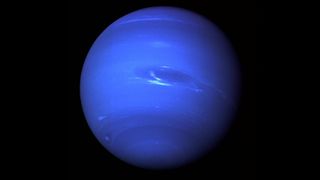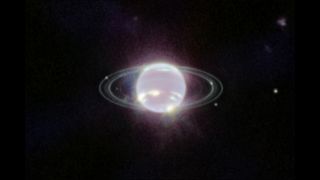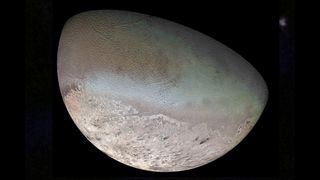Neptune: A guide to the windy eighth planet from the sun
Neptune is the farthest planet from the sun and was the first to be predicted before it was discovered.

Neptune is the eighth and farthest planet from the sun but it is not the coldest.
Our solar system's blue gas giant is far larger than Earth, at more than 17 times Earth's mass and nearly 58 times Earth's volume, according to NASA. Neptune's rocky core is surrounded by a slushy fluid mix of water, ammonia and methane ice.
Astronomer Galileo Galilei was one of the first people to identify Neptune as a space object, however, he assumed it was a star based on its slow movement.
Around two hundred years later, in 1846, French astronomer Urbain Jean Joseph Le Verrier calculated the approximate location of Neptune by studying gravity-induced disturbances in the motions of Uranus, according to a synopsis written by researchers at the University of St. Andrews in Scotland.
Related: What it would be like to live on Neptune's moon Triton
At the same time Le Verrier was calculating the existence of Neptune, so was English astronomer John Couch Adams. The two scholars independently came up with nearly identical mathematical predictions about Neptune's existence. Le Verrier then informed his colleague, German astronomer Johann Gottfried Galle, about his calculations, and Galle and his assistant Heinrich d'Arrest confirmed Le Verrier's predictions by viewing and identifying Neptune through the telescope at his observatory in Berlin.
In accordance with all the other planets seen in the sky, and as suggested by Le Verrier, this new world was given a name from Greek and Roman mythology — Neptune, the Roman god of the sea.
Only one mission has flown by Neptune — Voyager 2 in 1989. Today, there are still many mysteries about the cool, blue planet, such as why its winds are so speedy and its magnetic field is offset. While Neptune is interesting because it is in our own solar system, astronomers are also interested in learning more about the planet to assist with exoplanet studies. Specifically, astronomers are interested in learning about the habitability of worlds that are bigger than Earth.
Like Earth, Neptune has a rocky core, but it has a much thicker atmosphere that prohibits the existence of life as we know it. Astronomers are still trying to figure out at what point a planet is so giant that it may pick up a lot of gas in the area, making it difficult or impossible for life to exist.
Why is Neptune blue?
The planet's cloud cover has an especially vivid blue tint that is partly due to an as-yet-unidentified compound and the result of the absorption of red light by methane in the planet's mostly hydrogen-helium atmosphere.

By studying the cloud formations on the gas giant, scientists were able to calculate that a day on Neptune lasts just under 16 hours long.
Neptune is the fourth largest planet in the solar system, with a radius of 15,599.4 miles (24,622 kilometers) — the distance between its core and the surface. However, Neptune is a spheroid shape, meaning that it bulges around its equator, making the radius of the pole slightly smaller.
Neptune's elliptical, oval-shaped orbit keeps the planet an average distance from the sun of almost 2.8 billion miles (4.5 billion kilometers), or roughly 30 times as far away as Earth, making it invisible to the naked eye. A single orbit of the sun takes Neptune 165 Earth years to complete.
Despite Neptune's distance from the sun, which means it gets little sunlight to help warm and drive its atmosphere, Neptune's winds can reach up to 1,500 miles per hour (2,400 kilometers per hour), the fastest detected in the solar system so far. These winds were linked with a large dark storm that Voyager 2 tracked in Neptune's southern hemisphere in 1989.

This oval-shaped, counterclockwise-spinning "Great Dark Spot" was large enough to contain the entire Earth and moved westward at nearly 750 mph (1,200 km/h).
The storm seemed to have vanished when the Hubble Space Telescope searched for it later, and since then, Hubble has witnessed the appearance and then fading of other Great Dark Spots on Neptune over the past decade.
Because of the high temperatures and pressures on Neptune and Uranus, scientists believe compressed carbon in the form of diamonds causes a "diamond rain" phenomenon on these icy giants. In 2017, researchers could simulate the conditions that would cause diamonds to form in the lab, supporting the hypothesis that diamond rain occurs on Neptune and Uranus.
Neptune's magnetic poles are tipped to the side by roughly 47 degrees compared with the poles along which it spins. As such, the planet's magnetic field, which is about 27 times more powerful than Earth's, undergoes wild swings during each rotation.
Neptune FAQs answered by an expert
We asked planetary scientist Dr Michael Roman a few frequently asked questions about Neptune.
Dr Michael Roman is an expert on the giant planets of the solar system. He works as a planetary scientist at the University of Leicester, U.K.
What type of planet is Neptune?
Planetary scientists refer to Uranus and Neptune as 'ice giants' to emphasize that these planets are fundamentally different in bulk composition (and, consequently, formation) from the solar system's other giant planets, the 'gas giants' Jupiter and Saturn.
Based on their bulk densities (their overall masses relative to their sizes) Jupiter and Saturn must be composed mostly of the less massive ('lighter') elements, namely hydrogen and helium, even down into their deep interiors. Hence, they are called gas giants. However, in comparison, the bulk densities of Uranus and Neptune indicate that they must have significantly more heavy elements in their interior — specifically in the form of ammonia, methane, and water molecules — to explain their densities. They are, therefore, compositionally distinct, with implications for different formation processes and origins in the early solar system.
But why the term 'ice giant'? Astronomers and planetary scientists group molecules broadly by whether they are gaseous or solid at the cold temperatures found across the solar system. Hydrogen and Helium are gases at very low temperatures, whereas ammonia, methane and water condense and freeze to form ice. Hence, these heavier molecules are referred to as ices, and planets rich in these materials are classed as ice giants.
What is Neptune made of?
We can measure that the observable atmosphere is mostly hydrogen (more than 80%) and helium (~15%), with a small amount of methane and trace amounts of other molecules, including ethane, acetylene, and several other hydrocarbons.
However, as you go deeper into the planet, the composition must change, as the overall larger bulk density indicates that heavier elements must be present at greater depths. The bulk composition of Uranus and Neptune is roughly only 10–20% hydrogen and helium and 80–90% heavier elements, overall by mass. From our understanding of the fundamental chemical building blocks of the solar system, we can infer that these heavier elements are likely mostly methane, ammonia and water (that form ices), plus some elements that form rocks and metals. However, the relative proportions of the elements (including the ratio of ice to rock) and how they are distributed in the deep interior are unknown.
Why is Neptune not the coldest planet in the solar system if it is the most distant from the sun?
Interestingly, the upper atmospheres of both Uranus and Neptune are warmer than what theory would predict given their composition and the amount of sunlight they receive. This is an open mystery that has yet to be adequately explained. Furthermore, compared to Neptune, Uranus appears to have much less heat escaping from its deep interior and fewer trace gas molecules (that absorb sunlight) in its upper atmosphere. This leads to Uranus being somewhat colder, but the reasons for this are also unknown.
Why is it important that we learn about Neptune?
It is important that we study these planets for a number of reasons. The extreme atmospheric conditions and long seasonal timescales found in the ice giants provide a unique opportunity to better understand the physics of weather and climate. More fundamentally, these planets may also help us learn more about the formation of the solar system. Understanding why the bulk densities of Uranus and Neptune differ from Jupiter and Saturn can help us to better understand how planets formed and what processes shape planetary formation in general.
From a big-picture perspective, the ice giants are seen as possible representatives of a general class of planets that appear common across the galaxy. Studies looking at the variety of exoplanets discovered in recent years show that exoplanets with sizes roughly similar to Neptune are among the most numerous. By understanding the formation and characteristics of our local ice giants, scientists hope to better understand these vastly more distant planets and the processes by which they were formed.
Are there any plans for a mission to Neptune?
There are indeed proposals for a mission to Neptune to study the planet and its moons (particularly Triton). Recent U.S.-led proposals included Trident and Neptune Odyssey, among others, but missions to other targets were ultimately considered higher priorities by influential steering groups. No U.S. or European missions to Neptune are currently approved, although the Chinese National Space Administration has indicated it was planning a mission that would pass near Neptune and Triton later next decade. It will be a long wait for our next close view of Neptune, regardless.
Does Neptune have rings?

Neptune is surrounded by unusual rings, which aren't uniform but possess bright thick clumps of dust called arcs.
There are at least 5 rings around Neptune — called Galle, Leverrier, Lassell, Arago, and Adams — and they are considered relatively young and short-lived. According to an article in the journal Icarus, Earth-based observations found that Neptune's rings are apparently far more unstable than previously thought, with some dwindling away rapidly.
Neptune by the numbers
Atmospheric composition (by volume): 80% hydrogen, 19% helium, 1.5% methane
Magnetic field: Roughly 27 times more powerful than Earth's
Composition by mass: 25% rock, 60-70% ice, 5-15% hydrogen and helium
Internal composition: Mantle mantle of water, ammonia and methane ices; Core of iron and magnesium-silicate
Average distance from the sun: 2,795,084,800 miles (4,498,252,900 km) (that's 30.069 times farther than Earth)
Perihelion (closest approach to the sun): 2,778,182,000 miles (4,471,050,000 km) (that's 29.820 times that of Earth)
Aphelion (farthest distance from the sun): 2,819,080,000 miles (4,536,870,000 km) (that's 30.326 times that of Earth)
Mean orbit velocity: 12,158 mph (19,600 km/h)
Does Neptune have moons?
Neptune has 14 known moons, named after lesser sea gods and nymphs from Greek mythology. The largest by far is Triton, whose discovery on Oct. 10, 1846, was indirectly enabled by beer — amateur astronomer William Lassell, who discovered Triton used the funds he made as a brewer to finance his telescopes.

Triton is the only spherical moon of Neptune. The planet's other 13 moons are irregularly shaped. Triton is also unique in being the only large moon in the solar system to circle its planet in a direction opposite to its planet's rotation — this "retrograde orbit" suggests that Triton may once have been a dwarf planet that Neptune captured rather than forming in place, according to NASA. Neptune's gravity is dragging Triton closer to the planet, meaning that millions of years from now, Triton will come close enough for gravitational forces to rip it apart.
Triton is extremely cold, with temperatures on its surface reaching about minus 391 degrees F (minus 235 degrees C), making it one of the coldest places in the solar system. Nevertheless, Voyager 2 detected geysers spewing icy matter upward more than 5 miles (8 km), showing its interior appears warm. Scientists are investigating the possibility of a subsurface ocean on the icy moon. In 2010, scientists discovered seasons on Triton.
In 2020, NASA announced the possibility of a new space mission to visit Triton, called Trident. "Triton has always been one of the most exciting and intriguing bodies in the solar system," Louise Prockter, director of the Lunar and Planetary Institute of the Universities Space Research Association in Houston, who leads the Trident proposal team, said in the statement.
In 2013, scientists working with SETI caught sight of Neptune's "lost" moon of Naiad using data from the Hubble Space Telescope. The 62-mile-wide (100 km) moon had remained unseen since Voyager 2 discovered it in 1989.
Also in 2013, scientists using the Hubble Space Telescope found the 14th moon, dubbed S/2004 N 1. It is Neptune's smallest moon and is just 11 miles (18 km) wide. It got its temporary name because it is the first satellite (S) of Neptune (N) to be found from images taken in 2004, according to NASA.
Additional resources
To read more about how Neptune was discovered and plans for future research, read Thomas K. Adamson's "The Secrets of Neptune" (Capstone Press, 2015). Two great books about Neptune for kids are Nancy Loewen's "Farthest from the Sun: The Planet Neptune" (Picture Window Books, 2008), and Ellen Lawrence's "Neptune: The Stormiest Planet" (Ruby Tuesday Books, 2013).
Bibliography
- O'Conner, J.J. and E. F. Robertson, "Mathematical Discovery of Planets." University of St. Andrews Scotland, 1996.
- NASA, "Solar System Exploration - Overview: Neptune", accessed November 2022.
- NASA, "Neptune Fact Sheet", accessed November 2022.
- Stuart Gillespie, "There's a funny atmosphere on Neptune…", University of Oxford, July 2016.
Join our Space Forums to keep talking space on the latest missions, night sky and more! And if you have a news tip, correction or comment, let us know at: community@space.com.
Get the Space.com Newsletter
Breaking space news, the latest updates on rocket launches, skywatching events and more!

Charles Q. Choi is a contributing writer for Space.com and Live Science. He covers all things human origins and astronomy as well as physics, animals and general science topics. Charles has a Master of Arts degree from the University of Missouri-Columbia, School of Journalism and a Bachelor of Arts degree from the University of South Florida. Charles has visited every continent on Earth, drinking rancid yak butter tea in Lhasa, snorkeling with sea lions in the Galapagos and even climbing an iceberg in Antarctica. Visit him at http://www.sciwriter.us
- Scott DutfieldContributor
- Daisy DobrijevicReference Editor
